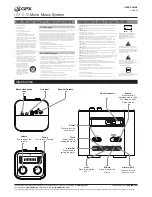
50
X.200
Digital X Bus
Applications for the MIDI Map include remote
transport control from MIDI applications that don’t
support MMC or the HUI protocol (but do allow
their own internal parameter mapping), surround
joystick control, or any continuous controller or
two-state switch application (lighting, remote
mixing, show controls, etc.) Any mapped control
information may be transmitted via manual adjust-
ment on the console, snapshot recall, and automa-
tion playback (which may include snapshot or other
Event track playback).
Menu
New MIDI Route
A route is made up of the following attributes:
• Selection:
The
fi rst column (with no column
heading) denotes the route number and selected
route within the map list. The number is a
simple identifi er, as there is no sorting mecha-
nism for the MIDI routes.
•
MIDI Type: This choice offers the type of MIDI
message. If the route is mapping a switch
parameter with two value states, it will be as-
signed as a Note message. If the parameter is
continuously variable, the Controller or After-
touch types may be used.
•
Number: This assignment is in the range of
0-127 decimal values for the associated MIDI
Type.
•
Channel: This is the MIDI channel that is used
for the selected route.
Note:
Maps using Ch 1 will not function when
DAW Emulation mode is enabled. If you are us-
ing a DAW Emulation, use only channel 2-16 for
MIDI routes.
•
Route To/From: This assigns the MIDI route to
a console channel strip, Aux master, Bus mas-
ter, Group, MIDI channel (Groups bank), DAW
channel (MIDI bank), or Left or Right Master.
The actual parameter within any chosen func-
tion is assigned in the Parameter column.
•
Parameter: Available choices follow whether
switch or variable control is selected under
MIDI Type.
•
Mode: The Mode option is enabled when Note
is selected as the MIDI Type. The two options
available are Normal and Toggle. These refer to
how the switch responds to received MIDI data
and is therefore only relevant if the Direction is
set to Receive.or Both.
In Normal mode, a Note On message engages
the switch and a Note Off (or Note On with
velocity of zero) disengages the switch.
In Toggle mode, alternating Note On messages
engage and disengage the switch, while Note
Off messages are ignored.
•
Direction: The MIDI route is set to Receive,
Send, or Both. Take care to avoid MIDI feed-
back.
Open MIDI Map…
•
Recalls a saved MIDI Map from disk. If a map
is currently in place, it well be entirely overwrit-
ten by the map from disk upon loading.
Save MIDI Map As…
•
Saves the current MIDI Map to disk as a Map
fi le, which is available for recall at a later date.
Delete MIDI Route
•
Deletes the currently selected Route(s) within
the list.
DAW Bank
Selecting DAW Bank under the Windows menu
switches to the DAW Bank (MIDI). This bank
allows you to control a number of DAW software
applications with the Digital X Bus. Select the DAW
application of your choice in the Emulation Mode
drop-down box. The on-screen buttons and V-Pots
map to the selected DAW application, simplifying
your ability to work with the Digital X Bus and the
DAW at the same time.
I/O Confi guration (Ctrl+0)
The I/O Confi guration window allows you to select
the various cards you have installed in the card
cage and customize their I/O confi gurations and
other settings for your session.
When the I/O Confi guration window opens, you
see a graphical representation of all the cards
installed in the card cage. Click a card to open the
setup window for that card. Depending on the card,
the options available will differ. Generally, for I/O
cards, you can rename the inputs and outputs, as-
Summary of Contents for X.200
Page 1: ...OWNER S MANUAL X 200 Manual Rev 1 0 4 March 7 2005...
Page 61: ...61 Owner s Manual Owner s Manual...
Page 82: ...82 X 200 Digital X Bus...
Page 93: ...93 Owner s Manual Owner s Manual...
Page 94: ...94 X 200 Digital X Bus Index...
















































